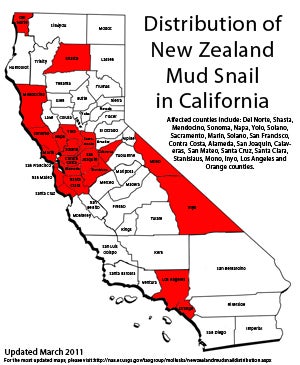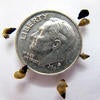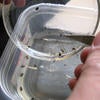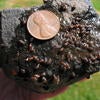New Zealand Mud Snail, Potamopyrgus antipodarum
The Situation: As the common name indicates, this invasive pest is native to New Zealand. New Zealand mud snail has had a long invasion history. It was first found in the United Kingdom in 1859, the western Baltic in Europe in 1887, the Mediterranean and eastern Europe were invaded in the 1950's. The snail has also established Australia and Japan. In 1987, New Zealand mud snail was found in Idaho (the Snake River). It has since spread through Yellowstone National Park, and is now found in Wyoming, Montana, and Oregon (1994). The Great Lakes were invaded in 1991. Genetic analyses suggest that the source population in the Great Lakes likely originated from Europe and invaders were introduced into the Great Lakes in ballast water discharged from transoceanic ships that came from Europe. The snail was found in British Columbia Canada in 2007, and the first record of this pest in California was from the Owens River which was officially confirmed in 2000. All western US states, except New Mexico, now have permanent populations of New Zealand mud snail.
The color of the snail shell is variable, and can range from gray and dark brown to light brown. The snail is usually 4-6 mm in length in areas that have been invaded, but snails can grow to almost twice this size, up to 12 mm, in New Zealand where populations are much lower. New Zealand mud snail is a nocturnal grazer that feeds on plant and animal detritus, algae, and diatoms. Invasive populations have an unusual mode of reproduction. New Zealand mud snails can reproduce asexually and female snails are born with developing embryos inside them. Consequently, all populations consist of genetically identical clones. In New Zealand, native mud snail populations consist of sexually reproducing populations (the males make up less than 5% of the populations) and asexually reproducing females. Each snail can produce around 230 offspring a year, and reproduction typically occurs during the spring and summer.
The Problem: New Zealand mud snail has likely been introduced into new areas by fishermen who have not properly cleaned equipment such as waders, wading boots, nets, and other gear. Because New Zealand mud snails are so small they are easily overlooked on fishing gear, and they are very resistant to desiccation. Snails can live for 24 hrs without water, and for up to 50 days on damp surfaces. This level of hardiness provides ample time for inadvertent movement of hitchhikers before they die. The snail is also tolerant of estuarine conditions and can live at depths of up to 45 m on solid and silty substrates. Once introduced into a new area, New Zealand mud snails can reach densities exceeding 500,000 per square meter. The exact implications of these incredibly high population densities are not certain. However, it is thought that such high snail populations probably have a negative affect on populations of other aquatic organisms, especially native snails and the insects and fish that feed on them. It is likely that freshwater ecosystems are adversely affected by such high populations of an invasive snail.
The highest concentration of New Zealand mud snails ever reported was in Lake Zurich, Switzerland, where the species colonized the entire lake within seven years to a density of 800,000 per square meter. Interestingly, these massive populations were not sustained, and a population crash due to unknown causes occurred. Consequently, New Zealand mud snails are not as common as they once were in Lake Zurich. A similar event was apparently observed in Denmark.
There are no known specialized natural enemies of New Zealand mud snail that have accompanied this invader as it has moved globally. Lack of predators, parasites, and pathogens has almost certainly promoted the invasion success of this pest. In New Zealand, the mud snail is attacked by 11 species of trematode, a type of parasitic flatworm, which sterilizes infected snails. This parasite may be important for regulating mud snail populations in New Zealand thereby preventing them reaching the incredible densities seen overseas. It is possible that host specific trematodes exist in New Zealand and these may be used to control pest populations of New Zealand mud snail if they can be shown to pose no risk to desirable native snail populations in areas that have been invaded by this pest.
Control of the New Zealand Mud Snail: Since there are no feasible eradication technologies, the first line of defense against New Zealand mud snail is containment. Since spread appears to be strongly associated with recreational freshwater fishing and wading gear, there are several recommended ways to reduce the risk of spreading New Zealand mud snail throughout California. Some suggested ways to decontaminate fishing gear include freezing overnight, or treating with chemicals known to be toxic to New Zealand mud snail. Many freshwater fishing websites have decontamination recipes for cleaning gear of New Zealand mud snail.
More Media on the New Zealand Mud Snail
MAGAZINE ARTICLE The WatchDog Magazine. California anglers face the quickening spread of river-borne invasive species. Published in November 2010
Center for Invasive Species Research, University of California Riverside
Text provided by: Mark S. Hoddle
Photos courtesy of D.L. Gustafson, Montana State and Robyn Draheim, Portland State University
Mark Hoddle, Extension Specialist and Director of Center for Invasive Species Research
mark.hoddle@ucr.edu
Personal Website







